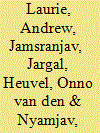| Srl | Item |
| 1 |
ID:
100030


|
|
|
|
|
| Publication |
2010.
|
| Summary/Abstract |
In comparison with their impacts elsewhere, humans have trodden relatively lightly on Mongolia's ecosystems and there is an opportunity to conserve globally threatened wild species and maintain natural ecological processes in parallel with modern economic development, but only if co-ordinated action is taken soon. Mongolia has a low population density (ca 1.68 per km2) and the pastoral lifestyle is suited to the landscape. Yet humans have degraded grasslands, damaged forests, depleted wildlife populations and polluted and overused water. Rapid social and political changes have resulted in far-reaching impacts on Mongolia's fragile ecosystems. The country is a major recipient of both foreign aid and foreign direct investment, and it is important to guide economic development with the best ecological judgment available before permanent damage is done. Government has a responsibility to establish a legal, policy and fiscal framework that provides incentives for sustainable use of the land compatible with the survival of Mongolia's wild species and ecosystems. A regional biodiversity conservation strategy for the Mongolian Altai examined direct and indirect threats and laid out a programme of actions under 12 major objectives.
|
|
|
|
|
|
|
|
|
|
|
|
|
|
|
|
| 2 |
ID:
161352


|
|
|
|
|
| Summary/Abstract |
This article challenges the ahistorical figure of the ‘steppe nomad’ by presenting some of the main characteristics of Kazakh nomadic pastoralism, which vary widely in time and space. It compares two ethnographic studies conducted a century apart in the same place in south-eastern Kazakhstan: a statistical survey from 1910 and an account of a transhumance in which the author took part in June 2012. Sedentary pastoralism now prevails in Kazakhstan, but a system of seasonal pastures endures in some areas. In Raĭymbek District (Almaty Province), vertical nomadism takes advantage of the altitudinal variations of vegetation and climate. This article demonstrates both the continuity of nomadic routes despite successive crises during the twentieth century, and considers the overall change from quasi-nomadism to quasi-sedentarism. This comparison a century apart also fosters dialogue between history and social anthropology through a dual synchronic approach, seeking to restore historicity to our understanding of pastoral nomadism.
|
|
|
|
|
|
|
|
|
|
|
|
|
|
|
|